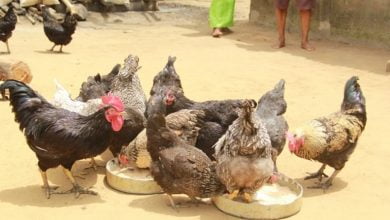STRESS IN POULTRY
Seema Agarwal and Naresh Singh Kuntal
Department of Pathology
College of Vety. & Animal Sciences
GBPUAT, Pantnagar – 263145,U.S. Nagar, Uttarakhand
Homeostasis mechanism regulates the internal environment of the body and helps in keeping the normal physiological function of the body. A deviation from normal body functions is called stress. Stress affects various factors of production and health of poultry. Body of birds have limited resources for growth, defence mechanism and reproduction. Stress is a major cause of deteriorating health in poultry which may develop vices such as feather picking, vent picking, egg eating, comb picking, etc due to it. Chickens kept in intensive conditions are constantly subjected to stress which is why farmers see such high mortality rates and have to spend large sums to keep their birds healthy and productive. Being in a stressful environment for long term makes a bird weak, affecting its immune system, and thus spreading infectious disease. Thus stress in poultry needs to be identified and managed for successful poultry production
Physiological Mechanism of Stress Regulation
Stress in poultry is an inevitable event. After a threshold level stress results in distress. Then birds show stress syndromes which are classified in three stages.
- Stage of Alarm reaction (Neurogenic System).
This system works for short – term regulation of stress. It consists of sympathetic nervous system and adrenal medullary tissue. It regulates the response to the animal like fight or flight i.e. emergency reaction. It is characterized by increased catecholamine secretion from the adrenal medulla. These catecholamines are responsible for “Fight or Flight” reaction and cause rapid release of glucose in blood, liver glycogen depletion, increased peripheral blood circulation, increased neural activity. Catecholamines also stimulate the formation of antibodies.
- Stage of Resistance or adaptation (Endocrine System)
This system works for long – term regulation of stress. In it there is involvement of endocrine system. It is comprised of hypothalamus – pituitary adrenal axis (HPA). It is characterized by increased synthesis and release of corticosterone which is responsible for the generation of glucose from body’s reserve of carbohydrates, lipid and proteins. Other hormones like Glucagon & Thyroid hormone are also involved in stress regulation.
- Stage of Exhaustaion
Exhaustion phase starts if the bird fails to recover from the stress stimuli and the body reserves and hormones from the adrenal gland are inadequate. Exhaustion phase leads to failure of the homeostatic mechanism and death.
| Types of Stress | Causes | |
| Climatic stress | – | Extreme heat and cold
high humidity |
| Environmental stress | – | Bright light
wet litter poor ventilation |
| Nutritional stress | – | Due to shortage of nutrients
feed intake problems change in diet |
| Physiological stress | – | Rapid growth
process of maturing egg laying or mating stress |
| Social stress | – | Poor body weight uniformity
over crowding |
| Psychological stress | – | Fear
harsh care takers |
| Pathological stress | – | Exposure to infectious agent |
| Immunological stress
|
– | Sub – clinical infections due to persist poor bio – security and sanitation |
In addition to categories of stress mentioned above other stressors are
- Handling
- Transportation
- Wet litter
- Dehydration
- Vaccination
- High ammonia level
- Toxins in feed
- De – beaking
- Lighting
- Medication
In addition to the above categories of stress, all the possible types of stressors can be broadly classified as avoidable stressors and unavoidable stressors. For better stress management there should be complete elimination of avoidable stressors and minimizing the unavoidable stressors on the birds.
Common Causes of Stress in Poultry
Some of the common causes of stress in poultry are
- Poor brooding condition – like cold water, low temperature
- Contaminated buildings / premises
- High stocking density – limited feeder and drinker space
- Temperature – heat and cold
- Vaccination, handling, weighing, grading and transport – cause pain, physical injury
- Beak trimming – causing pain and physical injury
- Lack of uniformity in body weight – differences in the packing order
- Rapid growth – strict nutritional requirement
- Post vaccination reaction – fever reduced feed intake
- Feed quality problems – variation in nutritional content
- Harsh care takers – poor husbandry
- Inadequate ventilation – deterioration of air quality
- Clinical or subclinical disease – reduced feed intake, fever, pain
- Poor litter condition – wet and cold
- Sexual maturity and egg laying – drastic stimulation with feed and light
Sign of stress
The most common stress sign are
- Aggression and fights
- Loss of weight
- Feather shedding
- Decrease egg production
- Lethargy and sluggish attitude
- Loss of appetite
Physiological indicator of stress in poultry
Several studies have done on the effects of stressors in poultry. There are some indicators of stress in birds such as
- Atrophy of thymus and atrophy of bursa of fabrics in young birds
- Enlargements of adrenal glands and the anterior pituitary
- Adrenal cholesterol depletion
- A rise level of plasma corticosterone
- A rise level of plasma insulin or glucagon
- Increased reliance on glucose as an energy source
- Hypoglycemia because of increased glucose utilization
- Decreased growth of muscles
- Increased muscle degradation
- Release of acute – phase cytokines like monokines and lymphokines
- Impairement in growth of cartilage and bone
- Synthesis of specific heat shock proteins
- Decreased feed intake i.e. anorexia
- Increased in the body temperature
- Changes in level of plasma metabolites (glucose, tryglyceride, non – estrified fattyacids).
- Changes in epinephrine content in yolk
- Changes in the numbers of circulating leucocytes profiles
- Immunosuppression
- Abdominal fat deposition
- Water belly condition i.e. ascites in high producing broilers
Prevention and Treatment
- Keep the birds clean and tidy – make the coop clean, timely change the flooring and coop
- Prevent overcrowding
- If number of birds increase than increase the number of feeder and waterer in respective ratio
- During severe heat – provide cooling facility
- During winter – provide bulbs or heater to warm the birds
- Timely vaccination – it will check the infection in the flock
- Prevent abrupt change in diet, make sure that diet is change gradually
Normally, a bird can handle a certain level of stress easily which varies from breed to breed. In short, stress is best avoided whenever possible and a little bit of care and forethought can dramatically reduce stress in poultry making them less prone to diseases, and hence increasing their production. There were studies done that measured the stress hormone ‘corticosterone’ of birds in different situations and it is this research that has enabled us to understand the stress stimulus.


